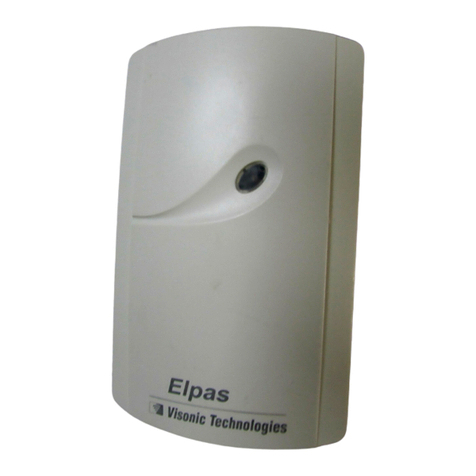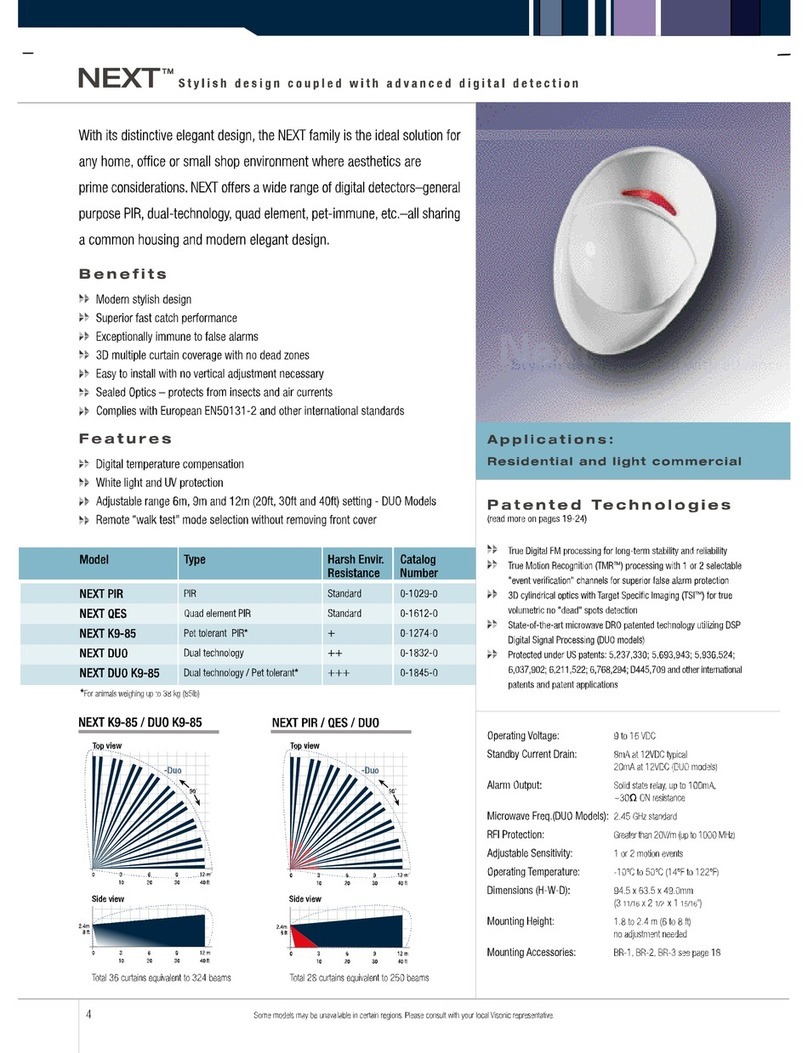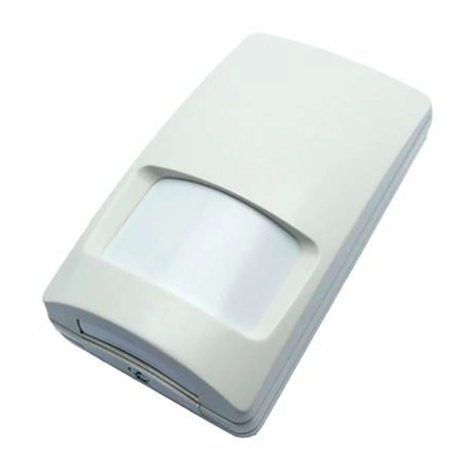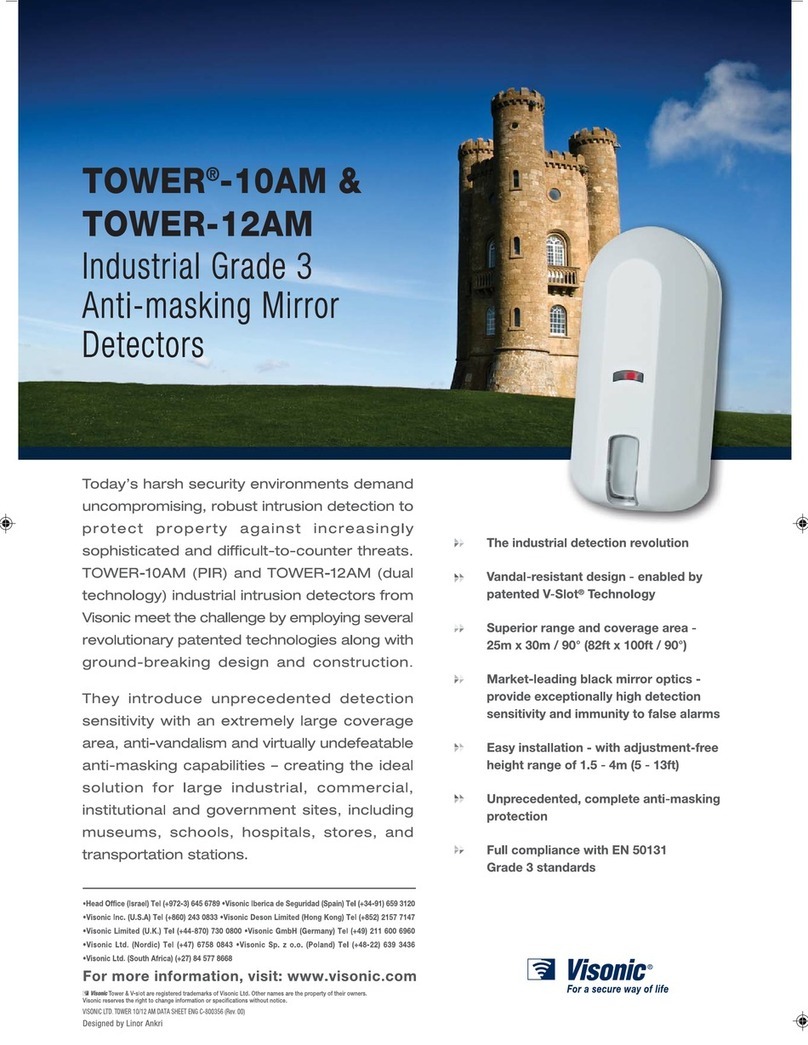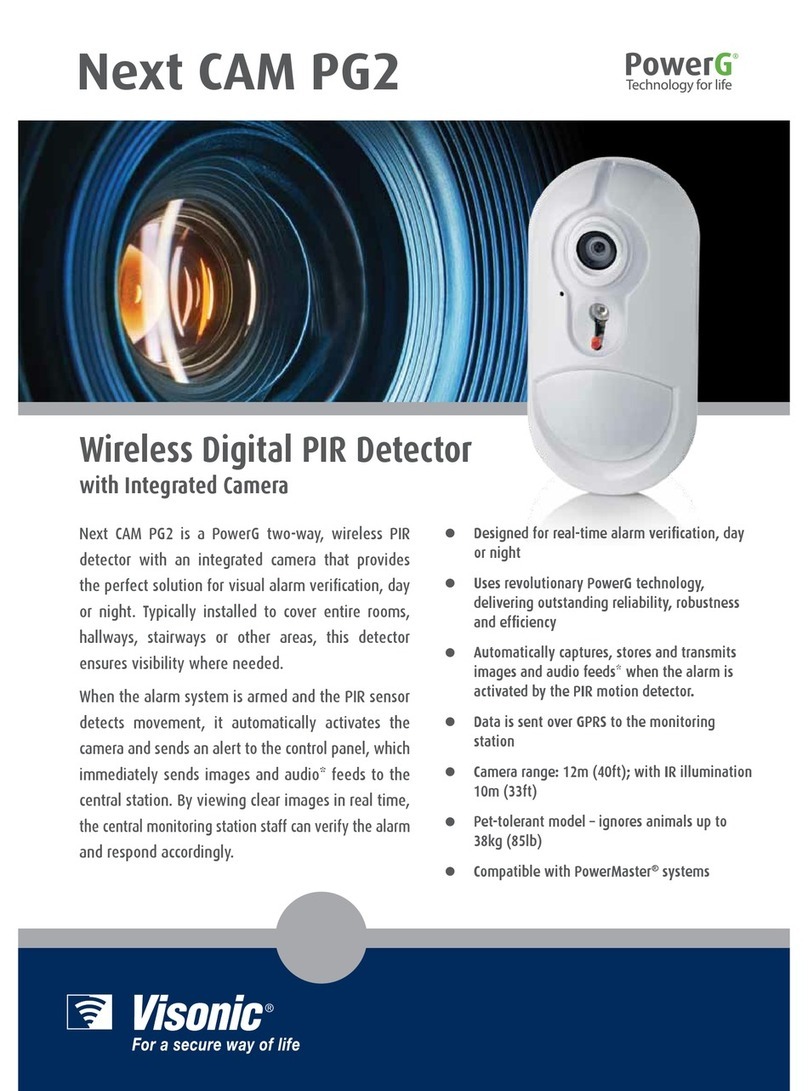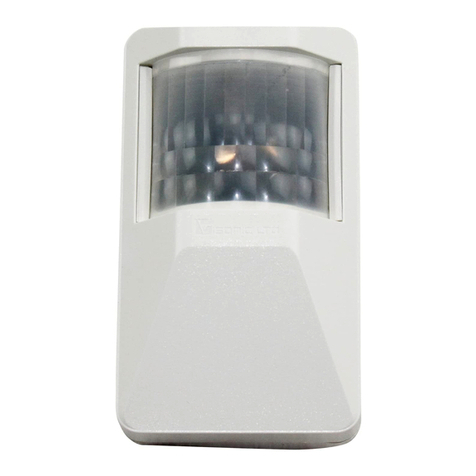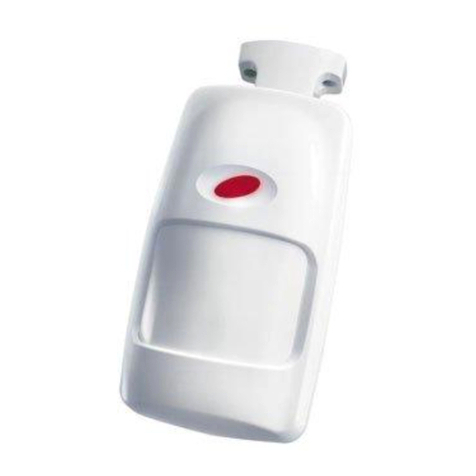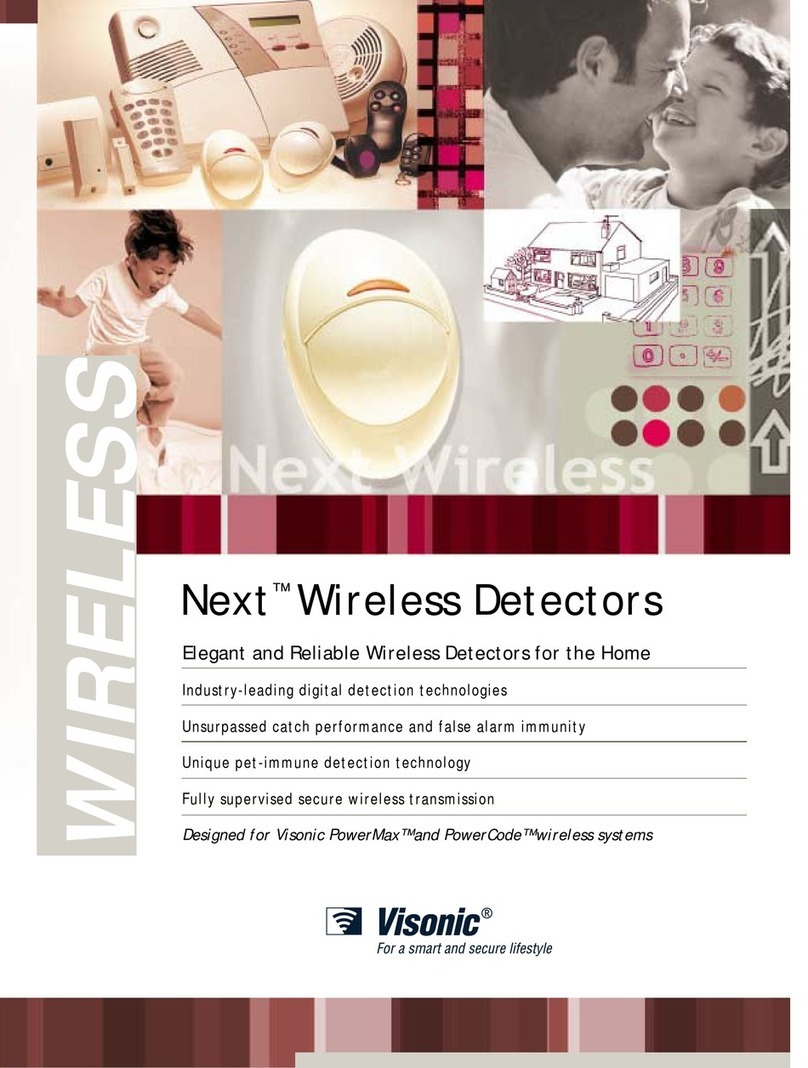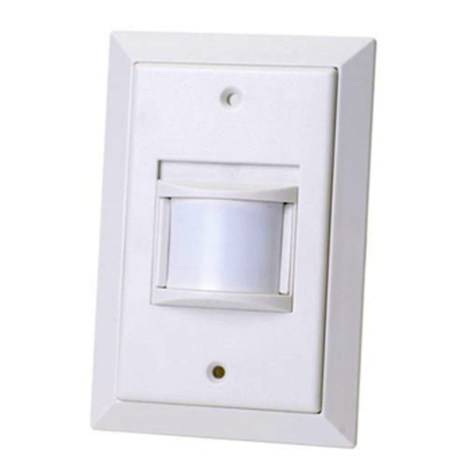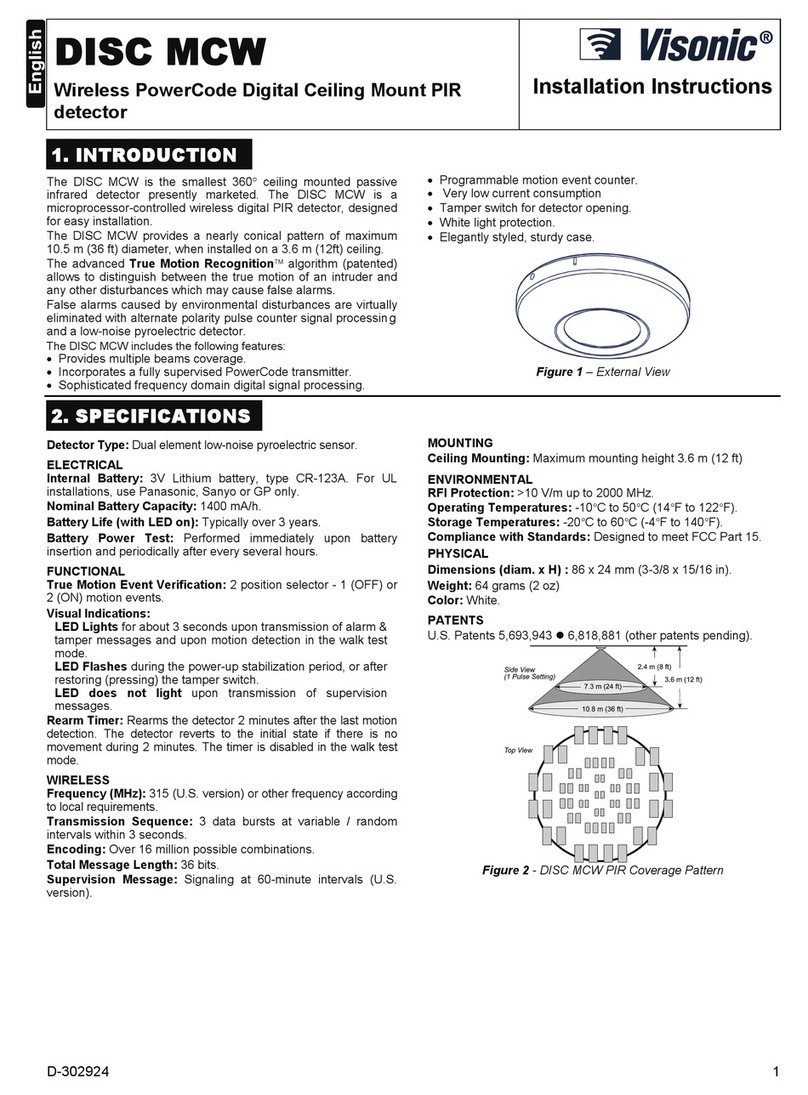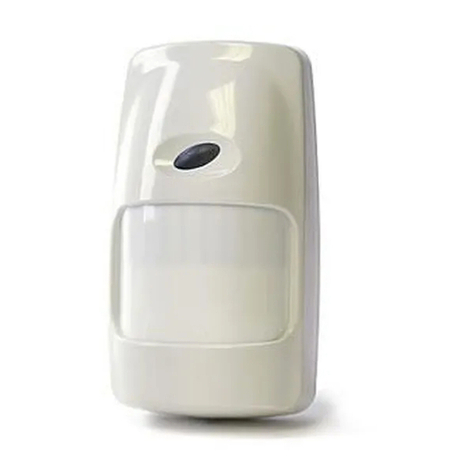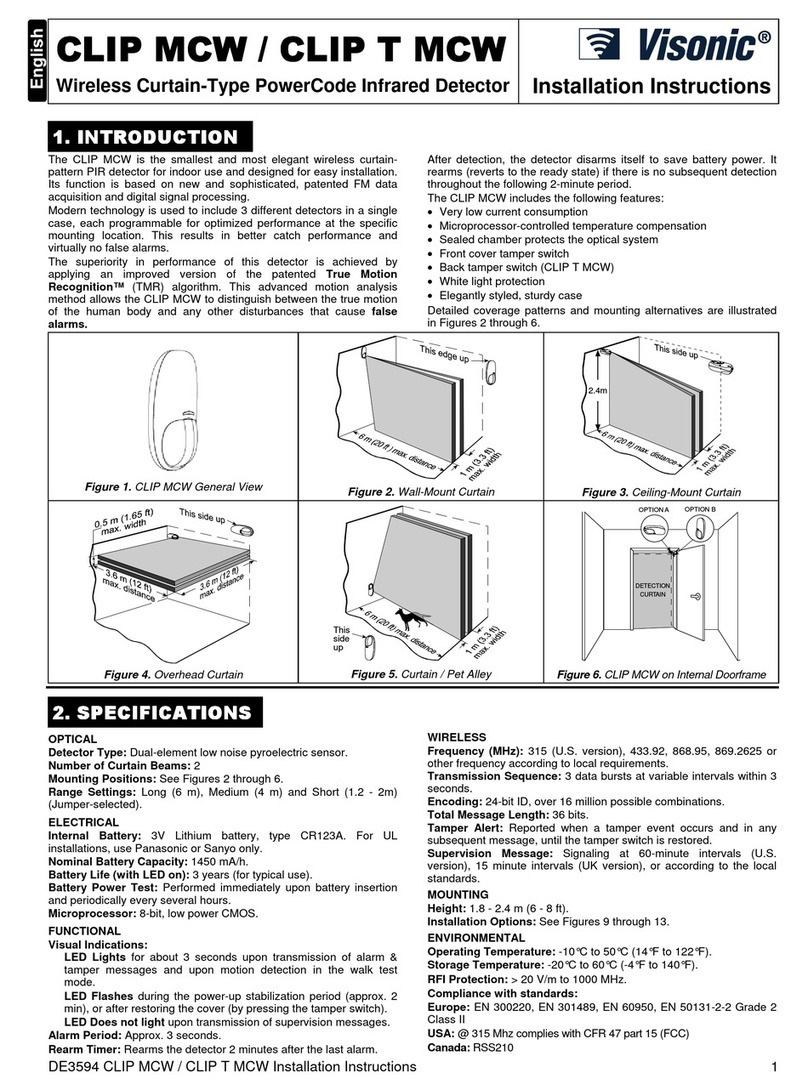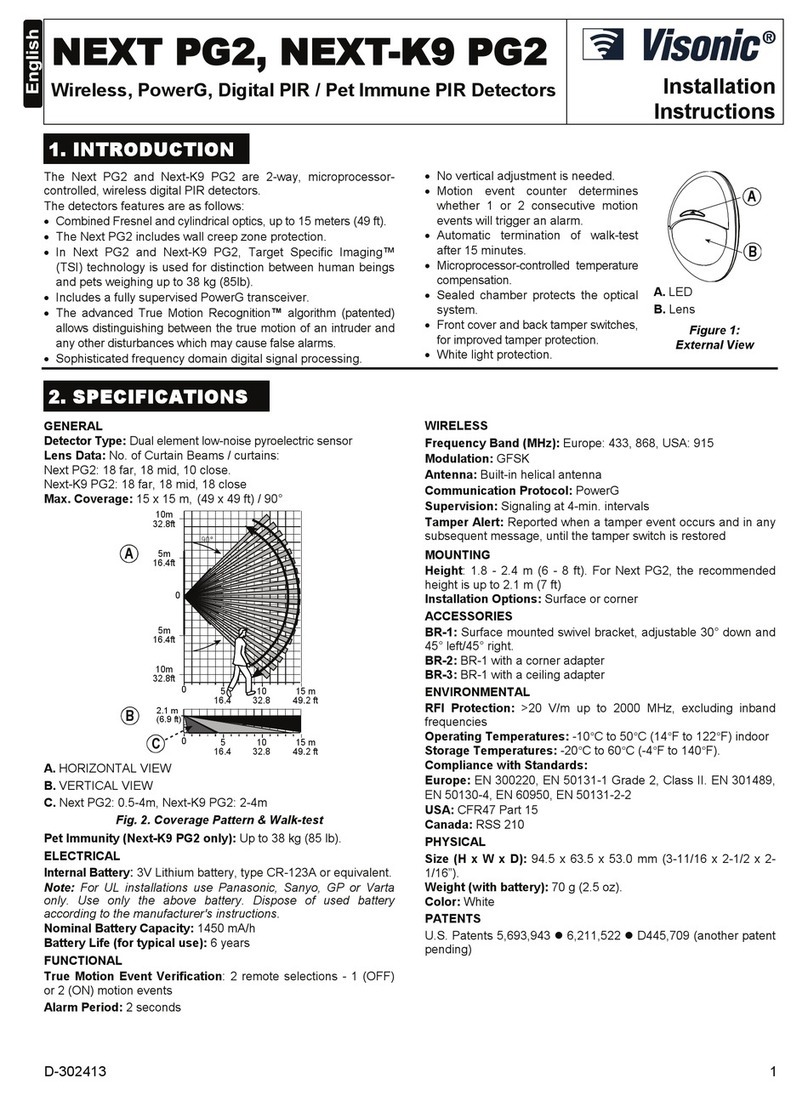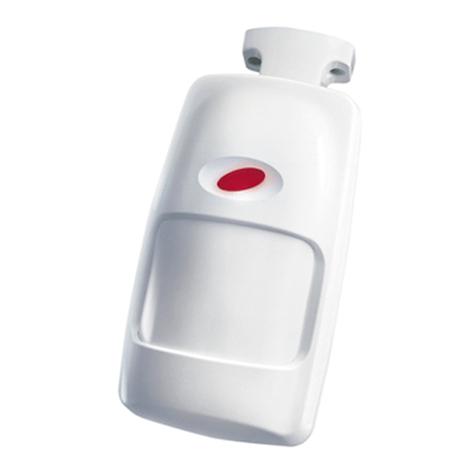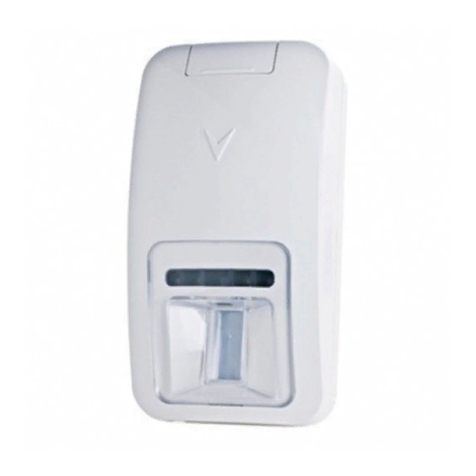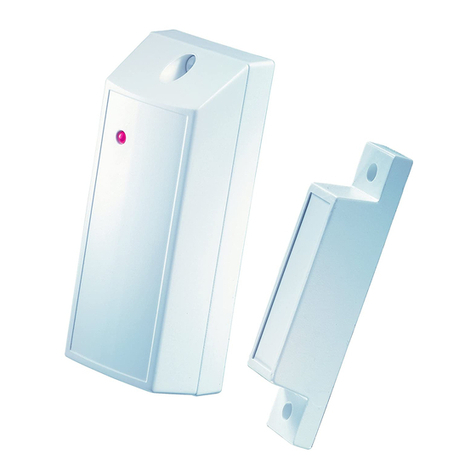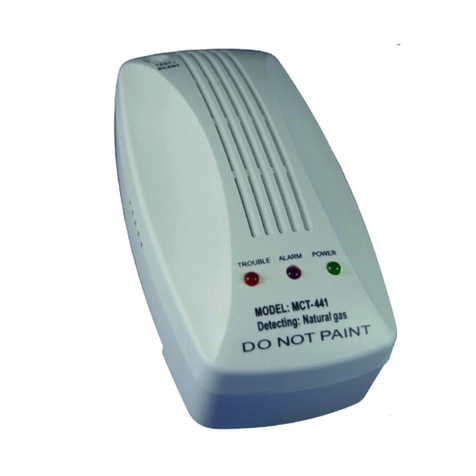
4 D-300431 DUET-AM C/O Installer Guide
the coverage area. The green light should flash for up to 5
seconds each time your motion is detected.
Note: If the LED lights green steadily for up to 5 seconds, your
motion has been detected by the MW sensor.
E. If PIR detection is not obtained at the far end of the coverage
area, remove the front cover and re-adjust the vertical position.
Replace the cover and retest.
3.11 MW Walk Test
A. Remove the front cover.
B. Verify that the MW RANGE control is set fully counterclockwise to
MIN and enable the LED either by setting mode switch SW-2 to
ON or by grounding the TST input.
C. Start by moving into the coverage area at the far edge. The LED
should light green for up to 5 seconds each time your motion is
detected.
D. If your motion was not detected at the far edge, advance the MW
RANGE control slightly clockwise toward MAX and try again until
your motion is detected reliably at the far edge.
Caution! The MW detection range must not exceed the far edge
of the desired coverage area.
E. Walk across the coverage area at various ranges and verify that
your motion is consistently detected.
Note: MW LEVEL CONTROL (see figure 4) may need to be set to
maximum for achieving maximum area coverage.
3.12 Alarm Walk Test
A. Make sure that the LED is enabled, either by setting mode switch
SW-2 to ON or by grounding the TST input.
B. Install the front cover in place.
C. Walk across the detector’s field of view in different directions, at
various distances from the detector, and verify proper alarming
throughout the detector's coverage area (the LED lights red for 1.3
to 5 seconds).
D. When done, disable the LED by setting set switch SW-2 to OFF or
by disconnecting the TST input (leaving it "floating").
E. Remount the cover and fasten it to the base using the small screw
at the bottom.
Attention! To assure proper function of the detector, the range and
coverage area should be checked at least twice a year.
Furthermore, it is recommended that users perform a walk test at
the far end of the coverage pattern to assure an alarm signal prior to
each time the alarm system is armed.
3.13 Resetting after Trouble
If trouble occurs while mode switch 3 is ON, proceed as follows:
Search for masking material on the lens or a masking object in
front of the lens and remove them, if found.
Reset the detector by walk testing: cross its field of view at the far
end, causing it to alarm several times.
If everything is back to normal, the LED should stop flashing, and the
TRB relay should revert to the closed circuit state.
Note: If walk testing does not cause the trouble alert to stop and
mode switch 3 is ON, recheck for masking. Once masking is ruled
out, the trouble must be due to faulty PIR or MW circuitry.
4. MISCELLANEOUS COMMENTS
This device has been tested and found to comply with the limits for a
Class B digital device, pursuant to Part 15 of the FCC Rules. These
limits are designed to provide reasonable protection against harmful
interference in residential installations. This equipment generates,
uses and can radiate radio frequency energy and, if not installed and
used in accordance with the instructions, may cause harmful
interference to radio and television reception. However, there is no
guarantee that interference will not occur in a particular installation. If
this device does cause such interference, which can be verified by
turning the device off and on, the user is encouraged to eliminate the
interference by one or more of the following measures:
– Re-orient or re-locate the receiving antenna.
– Increase the distance between the device and the receiver.
– Connect the device to an outlet on a circuit different from the one
which supplies power to the receiver.
– Consult the dealer or an experienced radio/TV technician.
Warning! Changes or modifications to this equipment not expressly
approved by Visonic Ltd. could void the user's authority to operate the
equipment.
WARRANTY
Visonic Limited (the “Manufacturer") warrants this product only (the "Product") to the original purchaser only (the
“Purchaser”) against defective workmanship and materials under normal use of the Product for a period of twelve
(12) months from the date of shipment by the Manufacturer.
This Warranty is absolutely conditional upon the Product having been properly installed, maintained and operated
under conditions of normal use in accordance with the Manufacturers recommended installation and operation
instructions. Products which have become defective for any other reason, according to the Manufacturers
discretion, such as improper installation, failure to follow recommended installation and operational instructions,
neglect, willful damage, misuse or vandalism, accidental damage, alteration or tampering, or repair by anyone
other than the manufacturer, are not covered by this Warranty.
The Manufacturer does not represent that this Product may not be compromised and/or circumvented or that the
Product will prevent any death and/or personal injury and/or damage to property resulting from burglary, robbery,
fire or otherwise, or that the Product will in all cases provide adequate warning or protection. The Product,
properly installed and maintained, only reduces the risk of such events without warning and it is not a guarantee
or insurance that such events will not occur.
THIS WARRANTY IS EXCLUSIVE AND EXPRESSLY IN LIEU OF ALL OTHER WARRANTIES, OBLIGATIONS
OR LIABILITIES, WHETHER WRITTEN, ORAL, EXPRESS OR IMPLIED, INCLUDING ANY WARRANTY OF
MERCHANTABILITY OR FITNESS FOR A PARTICULAR PURPOSE, OR OTHERWISE. IN NO CASE SHALL
THE MANUFACTURER BE LIABLE TO ANYONE FOR ANY CONSEQUENTIAL OR INCIDENTAL DAMAGES
FOR BREACH OF THIS WARRANTY OR ANY OTHER WARRANTIES WHATSOEVER, AS AFORESAID.
THE MANUFACTURER SHALL IN NO EVENT BE LIABLE FOR ANY SPECIAL, INDIRECT, INCIDENTAL,
CONSEQUENTIAL OR PUNITIVE DAMAGES OR FOR LOSS, DAMAGE, OR EXPENSE, INCLUDING LOSS
OF USE, PROFITS, REVENUE, OR GOODWILL, DIRECTLY OR INDIRECTLY ARISING FROM
PURCHASER’S USE OR INABILITY TO USE THE PRODUCT, OR FOR LOSS OR DESTRUCTION OF
OTHER PROPERTY OR FROM ANY OTHER CAUSE, EVEN IF MANUFACTURER HAS BEEN ADVISED OF
THE POSSIBILITY OF SUCH DAMAGE.
THE MANUFACTURER SHALL HAVE NO LIABILITY FOR ANY DEATH, PERSONAL AND/OR BODILY
INJURY AND/OR DAMAGE TO PROPERTY OR OTHER LOSS WHETHER DIRECT, INDIRECT, INCIDENTAL,
CONSEQUENTIAL OR OTHERWISE, BASED ON A CLAIM THAT THE PRODUCT FAILED TO FUNCTION.
However, if the Manufacturer is held liable, whether directly or indirectly, for any loss or damage arising under this
limited warranty, THE MANUFACTURER'S MAXIMUM LIABILITY (IF ANY) SHALL NOT IN ANY CASE
EXCEED THE PURCHASE PRICE OF THE PRODUCT, which shall be fixed as liquidated damages and not as a
penalty, and shall be the complete and exclusive remedy against the Manufacturer.
When accepting the delivery of the Product, the Purchaser agrees to the said conditions of sale and warranty and
he recognizes having been informed of.
Some jurisdictions do not allow the exclusion or limitation of incidental or consequential damages, so these
limitations may not apply under certain circumstances.
The Manufacturer shall be under no liability whatsoever arising out of the corruption and/or malfunctioning of any
telecommunication or electronic equipment or any programs.
The Manufacturers obligations under this Warranty are limited solely to repair and/or replace at the
Manufacturer’s discretion any Product or part thereof that may prove defective. Any repair and/or replacement
shall not extend the original Warranty period. The Manufacturer shall not be responsible for dismantling and/or
reinstallation costs. To exercise this Warranty the Product must be returned to the Manufacturer freight pre-paid
and insured. All freight and insurance costs are the responsibility of the Purchaser and are not included in this
Warranty.
This warranty shall not be modified, varied or extended, and the Manufacturer does not authorize any person to
act on its behalf in the modification, variation or extension of this warranty. This warranty shall apply to the
Product only. All products, accessories or attachments of others used in conjunction with the Product, including
batteries, shall be covered solely by their own warranty, if any. The Manufacturer shall not be liable for any
damage or loss whatsoever, whether directly, indirectly, incidentally, consequentially or otherwise, caused by the
malfunction of the Product due to products, accessories, or attachments of others, including batteries, used in
conjunction with the Products. This Warranty is exclusive to the original Purchaser and is not assignable.
This Warranty is in addition to and does not affect your legal rights. Any provision in this warranty which is
contrary to the Law in the state or country were the Product is supplied shall not apply.
Warning: The user must follow the Manufacturer’s installation and operational instructions including testing the
Product and its whole system at least once a week and to take all necessary precautions for his/her safety and
the protection of his/her property.
1/08
W.E.E.E. Product Recycling Declaration
For information regarding the recycling of this product you must contact the company from which you orignially purchased it. If you are discarding this product and not
returning it for repair then you must ensure that it is returned as identified by your supplier. This product is not to be thrown away with everyday waste.
Directive 2002/96/EC Waste Electrical and Electronic Equipment.
INTERNET: www.visonic.com
VISONIC LTD. 2014 DUET-AM C/O D-300431 REV. 3, 7/14
R

